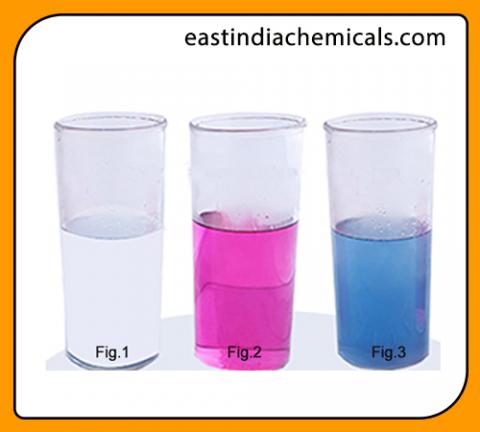Primary tabs

Sulphite (Sulfite) Lab Test Method
SKU::RXSOL-62-5503-007
Summary of Method The water sample is acidified and titrated with a potassium iodide-iodate standard solution. The acid releases free iodine, which is reduced to colorless iodide by the sulfite in the sample. When all of the sulfite is gone, the iodine reacts with the starch indicator to form a blue color.
Reagents
Sulfuric acid, H2 SO4 ::: RXSOL-60-6186-500
Starch indicator ::: RXSOL-60-6221-100
Sulfite Indicator Powder: ::: RXSOL-62-5503-005 a proprietary formulation containing sulfamic acid to destroy nitrite.
Standard potassium iodide-iodate titrant ::: RXSOL-62-5503-006 This titrant is equivalent to 500 mu (μ) g SO3 /1.00 mL.
Sulfamic Acid: Crystalline
EDTA Reagent ::: RXSOL-60-6168-500 Dissolve 2.5 g EDTA in 100 mL distilled water.
Procedure
Sampling Contact with air must be minimized. If the sample temperature is greater than 50°C, it must be cooled in a air tight apparatus. Immediately add 1 mL of EDTA Solution (5.6) per 100 mL of sample.
1st Method
Place 1 mL H2SO4 in titration vessel.
Add 0.1 g sulfamic acid crystals.
Add 50 mL sample.
Add approximately 0.1 g starch indicator.
Titrate with potassium iodide-iodate titrant (5.4) until a faint permanent blue color develops. Keep the pipet tip below the surface of the sample. View the color change against a white background. Record the mL titrant. ---- VALUE of A
Run a reagent blank using distilled water instead of sample.
2nd Method
Place 50 mL sample in a titration vessel.
Add 3-4 drops phenolphthalein indicator.
Add sufficient scoops (1 g) of indicator ( Sulfite Indicator Powder: ::: RXSOL-62-5503-005 ) to discharge the red color.
Titrate with potassium iodide-iodate titrant until a faint permanent blue color develops. View the color change against a white background. Record the mL titrant. ---- VALUE of A
Run a reagent blank using distilled water instead of sample.
Formula Calculation :::
mg/L SO3 = A x N x 40000
mL sample
where:
VALUE of A = mL titrant
N = Normality of KI-KIO titrant ( 0.0125 N )
To calculate as Na2SO3
mg/L Na2SO3 = mg/L SO3 x 1.57
|
A x N x 40000 / mL sample |
|
A x N x 40000 / mL sample |
|
A x N x 40000 / mL sample |
Interfering substance
Interference level Metals Some metals, especially copper, catalyze the oxidation of sulfite to sulfate. Immediately add Sulfite Indicator Powder: ::: RXSOL-62-5503-005 for each liter of sample during sample collection to prevent the interference.
Nitrite Reacts with sulfite and causes low results.
Organic compounds Oxidizable organic compounds can cause high results.
Oxidizable compounds Cause high results.
Sulfide Causes high results.
Dose of Sulfite can be controlled by this method ::: Because it readily reacts with oxygen to form sulfate, sulfite is not usually found in natural water systems. In its most common form, sodium sulfite, it is widely used as an oxygen scavenger in feedwater conditioning to prevent pitting in boilers; as a pulping or pulp-bleaching agent by the paper industry; to neutralize residual chlorine in potable water, sewage, industrial effluents, and textile process waters; and as a reducing agent in still other manufacturing processes.
Sample water over 100°F will cause a false-high reading; therefore, quickly cool to room temperature before testing. To prevent a false-low reading caused by the reaction between sulfite and ambient air or dissolved oxygen, water samples should be capped while cooling and then tested without delay. An iodometric drop test is the most popular field method for determining sodium sulfite concentrations.
Reagent packs, containing an instruction and chemicals only, may be purchased for use with buret setups. Note: Sulfide and ferrous iron cause positive interference; copper and nitrite cause negative interference.
Limitations of Test :::
This method is rapid and adaptable to field determinations. It is affected by any oxidizable substances in the water such as organic matter sulfides and nitrites. The presence of these interfering substances will cause the sulfite content obtained from this titration to by shown as a higher value than actually exists.
Sulphite (Sulfite) Lab Test Method manufacturer supplier distributor in Mumbai, Kandla, Kolkata, Vizag, Chennai, India, Fujairah, Dubai, Sharjah, UAE, Gulf, Middle East, Muscat Oman, Kenya Africa. Get the best quality of Sulphite (Sulfite) Lab Test Method at a competitive price from us. We have ready stock of Sulphite (Sulfite) Lab Test Method in India, UAE Gulf, Oman, Kenya Africa. Contact us for bulk as well as small orders.
Samples must be analyzed immediately after collection and cannot be preserved for later analysis.
Let the sample temperature decrease to 50 °C (122 °F) or less before analysis.
Sulfite reacts quickly with oxygen in the air. Shaking or swirling the sample causes low results. Prevent agitation of the sample during the procedure.
Review safety chemical handling procedure. Use the recommended personal protective equipment. Dispose of reacted solutions according to local, state and federal regulations. Follow the environmental safety, health safety staff for your facility and/or local regulatory agencies for further disposal information.



